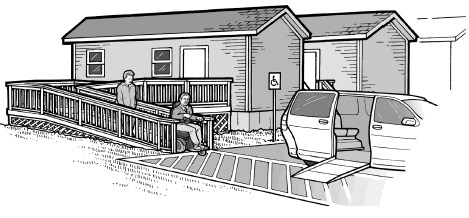An ADA Guide for Local Governments: Making Community Emergency Preparedness and Response Programs Accessible to People with Disabilities
RETURNING HOME
The needs of individuals with disabilities should be considered, too, when they leave a shelter or are otherwise allowed to return to their home. If a ramp has been destroyed, an individual with a mobility impairment will be unable to get into and out of the house. In case temporary housing is needed past the stay at the shelter, your emergency response plan could identify available physically accessible short-term housing, as well as housing with appropriate communication devices, such as TTY’s, to ensure individuals with communication disabilities can communicate with family, friends, and medical professionals.
Action Steps: Planning
Identify temporary accessible housing (such as accessible hotel rooms within the community or in nearby communities) that could be used if people with disabilities cannot immediately return home after a disaster if, for instance, necessary accessible features such as ramps or electrical systems have been damaged.

A portable trailer provides temporary accessible housing for an individual who uses a wheelchair and his family. In addition to accessible features inside, the trailer also has an accessible entrance, accessible parking, and the trailer is located on an accessible route to other site features in the mobile home park.

User Comments/Questions
Add Comment/Question